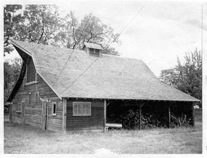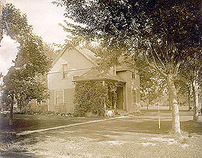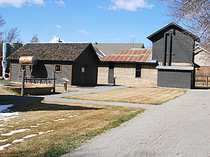
Hover Farmstead
1303 Hover Road | Longmont, Colorado
SVHS began work to preserve the Hover farmstead with the purchase of the original farmhouse in 1994 and the other agricultural buildings in 1996. Initial restoration of the farmhouse and farm buildings was completed in 1997, as was the reconstruction of the Hover Barn which had been destroyed in an arson fire in 1995.
In January 1999, Hover Farmstead was entered as an historic district in the National Register of Historic Places. The society continues the preservation efforts and development of this historic district for the benefit of the community.
Today, surrounded by residential development and growth, the Hover Farmstead is a powerful reminder of Longmont’s disappearing agricultural heritage.
Public tours of the farmstead can be scheduled through the SVHS office at
(303) 776-1870.
The History
When Charles Hover decided to leave the press of business and city life in Denver in 1902, he purchased the Williamson Place , a 160 acre farm on a dusty country lane two miles northwest of the small town of Longmont. Paying $11,200 for the land and 15 shares of Longmont Supply Ditch water, Hover found himself owner of a none-too-productive acreage plagued by alkali problems . Although he had never farmed before, Hover was a voracious reader of agricultural materials and set about improving the farm based on what he called “a scientific method”.
He installed an innovative drainage system to remove alkali deposits from low areas, and planted part of the farm in alfalfa to replenish the nitrogen in the soil. Then he introduced livestock, both cattle and sheep, which he referred to as his “fertilizer factory”. Alfalfa silage from his newly built mill was fed to the livestock and all manure was returned to the fields, together with patent fertilizers. A systematic program of crop rotation was established for the wheat, alfalfa and beet crops.
During the first ten years on the farm, Hover and his wife lived in a cottage built to the north of the original 1893 farmhouse, which they turned over to the farm foreman. Hover personally supervised all the improvements, including new farm buildings and the addition of the latest and most innovative equipment. A complete blacksmith’s shop was installed , as well as a heated stock tank for the livestock. Within ten years the productivity of the farm had improved so much that one Denver newspaper headlined a 1912 story: “Prairie Farm is Paradise in Ten Years”.
Agricultural Leadership was Charles Hover’s primary legacy. Although a tenant assumed the operations of the farm after 1913, Hover continued to oversee the selection and rotation of crops. Most of the crops were grown for seed, and he developed several new rust-resistant strains of wheat.
Hover’s influence in agricultural matters reached far beyond the borders of his farm. One Denver newspaper noted: “When Mr. Hover rises in the councils of the State Farm Bureau, his words command attention.” President of both the Boulder County and Colorado Farm Bureaus, he was also a force in the Colorado Wheat Congress and several national agricultural organizations, as well as the driving force behind the revival of the Boulder County Fair.
The Farmstead Buildings
The farmhouse buildings include an 1893 farmhouse, and a collection of agriculture buildings- barn, mill, chicken house, wood shed, creamery and garage – all thought to have been constructed by 1912. They reflect the spatial layout, materials and construction methods associated with successful early 20th century Colorado farms.














